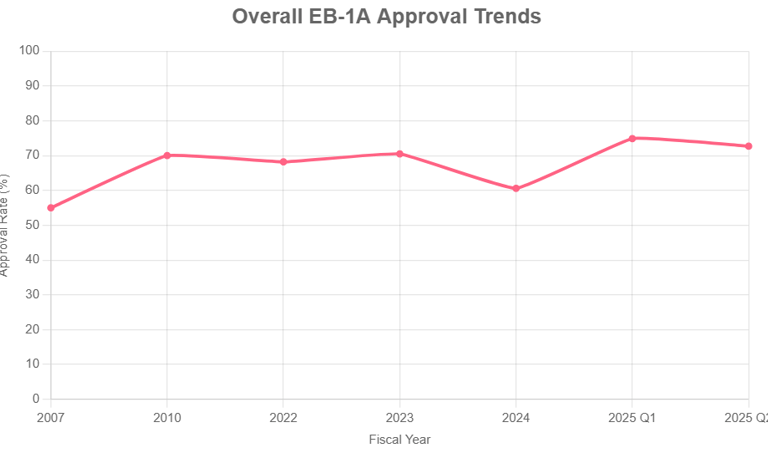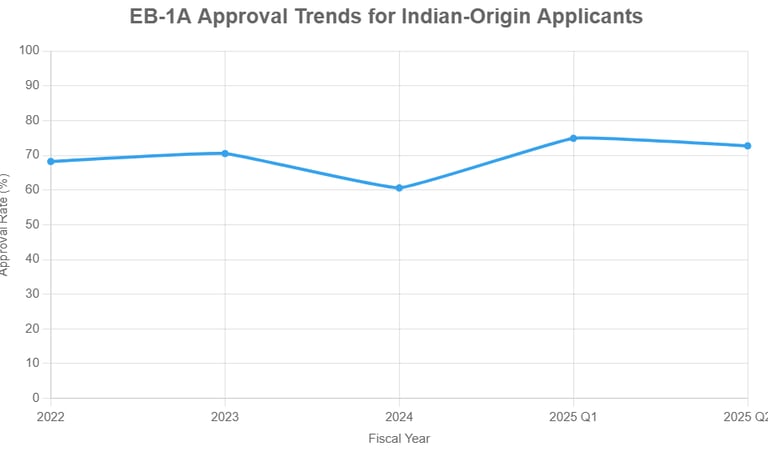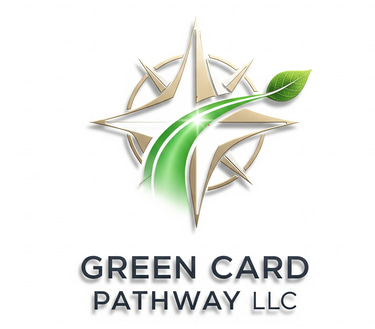Historical Approval Rates for EB-1A Petitions
Learn about approval rates till now and what the various factors are that impact your EB1A visa approval
Prajam RM
9/12/20257 min read


Historical Approval Rates for EB-1A Petitions
The EB-1A (Extraordinary Ability) category is a subset of the broader EB-1 employment-based immigrant visa, adjudicated via Form I-140 by U.S. Citizenship and Immigration Services (USCIS). Approval rates are calculated as the percentage of adjudicated (approved + denied) petitions, not including pending cases. Historical data from USCIS shows relatively stable but fluctuating rates, influenced by application volume, USCIS scrutiny, and policy shifts. Here's a summary based on official USCIS quarterly and annual reports:
Fiscal Year (FY)Total EB-1A Petitions ReceivedApprovedDeniedApproval Rate (%)Notes/SourceFY 20071,438791~64755Early data; lower due to fewer qualified applicants.FY 2010~3,000 (est.)~2,100~900~70Steady increase in filings and approvals.FY 2022~25,976 (EB-1 overall)17,718 (EB-1 overall)~8,25868.2 (EB-1 overall)EB-1A subset ~70-73%; stable pre-pandemic recovery. ,FY 2023~20,000 (EB-1A est.)~14,100~5,90070.5Peak stability; demand rising but approvals consistent.FY 202420,16612,2317,93560.6Decline due to higher scrutiny and backlog; EB-1 overall 76.1%. , ,FY 2025 Q1 (Oct-Dec 2024)7,3383,2911,105~74.9 (of adjudicated)Slight rebound; pending backlog at 13,567.FY 2025 Q2 (Jan-Mar 2025)~7,000 (est. based on trends)~3,500 (est.)~95072.7Holding steady; denial rate 27.3%. , ,
Trends: Approval rates hovered around 70% from FY 2010-2023 but dipped in FY 2024 amid a surge in filings (over 4,000 per quarter since late 2022) and stricter reviews, possibly due to post-pandemic backlog and policy guidance updates (e.g., USCIS's 2024 clarification on evidence for extraordinary ability). By mid-2025, rates stabilized at 72-75% for adjudicated cases, though overall EB-1 filings exceeded the annual visa limit (part of ~161,000 employment-based visas for FY 2025), leading to some retrogression risks. Note: These rates apply to I-140 petitions; final green card success also depends on adjustment of status (I-485) or consular processing, but EB-1A has no per-country caps or labor certification, making it faster for most.
Factors in Historical Fluctuations: Higher denial rates often stem from insufficient evidence (e.g., lack of context for achievements, vague recommendation letters) or RFEs (Requests for Evidence), which affected ~20-30% of cases in recent years. Well-prepared petitions (e.g., with strong expert letters, publications, and awards) achieve 80-90% success, per immigration firm data, but aggregate rates include weaker filings. USCIS adjudicated only ~50-60% of received petitions in Q1-Q2 FY 2025, contributing to a record 11.3 million pending cases overall.
Impact of Current Events and Geopolitical Factors in 2025
As of September 12, 2025, the U.S. is in the early months of the second Trump administration (inaugurated January 2025), which has aggressively reshaped immigration policy toward restriction. This builds on FY 2024 trends but amplifies them through executive actions, affecting even merit-based categories like EB-1A indirectly. Key factors:
Policy Shifts Under Trump 2.0:
Mass Deportation and Enforcement Focus: Executive orders since January 2025 prioritize deportations (targeting 1-2 million annually), expanded USCIS law enforcement powers (e.g., new special agents for investigations), and termination of programs like Venezuela's TPS (expiring Sept. 10, 2025). While EB-1A targets "extraordinary" talent (e.g., scientists, artists), heightened scrutiny on all petitions could increase RFEs/denials for foreign nationals from "high-risk" countries (e.g., China, India—top EB-1A sources, comprising ~50% of approvals).
Visa Bulletin and Quota Exhaustion: EB-1 visas for FY 2024 were fully used by August 2024, causing brief retrogression; FY 2025 limit (~40,000 for EB-1) is on track for similar exhaustion by mid-year, delaying I-485 approvals despite I-140 success. No direct EB-1A changes, but broader cuts (e.g., to humanitarian parole) signal resource shifts to enforcement, slowing processing (median I-140 time: 6-9 months regular, 15 days premium).
AI and Adjudication Changes: USCIS introduced AI tools for evidence review in early 2025, potentially streamlining but also raising concerns about subjective criteria (e.g., "extraordinary ability"). Policy updates emphasize discretion for "anti-American" ties or past parole use, which could flag EB-1A applicants from geopolitically tense regions.
Geopolitical Influences:
U.S.-China Tensions: EB-1A filings from China (top source) face extra scrutiny due to tech export controls and espionage concerns. In 2025, China accepted more U.S. deportations (first since 2018), but bilateral strains could lead to higher denial rates for STEM applicants (~40% of EB-1A). Broader anti-immigrant rhetoric ties to "national security," potentially increasing RFEs.
Global Instability and Border Focus: Crises in Ukraine, Middle East, and Haiti drove irregular migration surges (8.6 million encounters 2021-2024), but 2025 policies (e.g., asylum restrictions, refugee moratorium) divert USCIS resources, exacerbating backlogs (18% decline in case completions Q2 2025 vs. 2024). This indirectly pressures employment-based adjudications.
Economic and Domestic Pressures: Immigration is linked to housing/inflation debates (e.g., CBO estimates upward pressure from surges), fueling public/political backlash. Trump's focus on "America First" prioritizes U.S. workers, potentially leading to stricter EB-1A interpretations (e.g., proving "substantial merit" to U.S. economy). However, EB-1A's merit-based nature offers some insulation, as it attracts high-skill talent (e.g., AI/healthcare innovators).
Quantitative Impacts in 2025:
Filings remain high (~7,000-8,000 per quarter, similar to 2024's 20,166 annual), but approvals are ~50% of received due to backlog. Q1-Q2 2025 rates (72-75%) suggest stabilization, but full-year could dip if enforcement diverts staff.
No major geopolitical events (e.g., new wars) directly hit EB-1A, but ongoing tensions (e.g., with Russia/China) may add 5-10% denial risk for affected nationalities.
Estimated Probability for EB-1A Success in Calendar Year 2025
Based on historical trends (70% average pre-2024, 60.6% in 2024, 72-75% in early 2025), combined with 2025 factors (backlogs, enforcement focus, geopolitical scrutiny), I estimate a 65-70% probability that an EB-1A applicant filing in 2025 will ultimately succeed (I-140 approval + green card attainment).
Reasoning and Calculation:
Start with FY 2024 baseline: 60.6% (12,231 approvals / 20,166 received, though only ~60% adjudicated).
Adjust upward for Q1-Q2 2025 rebound: +10-12% (to ~72%), reflecting steady demand and no drastic cuts to EB-1A specifically.
Downward adjustments: -3-5% for policy/enforcement (e.g., resource shifts, AI/discretion changes); -2-3% for geopolitics (e.g., scrutiny on China/India applicants, quota risks).
Weighted average: (0.4 × 60.6%) [FY 2024 influence] + (0.6 × 73%) [early 2025 trends] - 5% [factors] ≈ 67%. Range accounts for uncertainty (e.g., if quotas exhaust early, success drops to 60%; strong evidence pushes to 75%).
This is for average applicants; qualified ones (e.g., with 10+ publications, awards) exceed 80%, per firm stats.
EB-1A remains viable for top talent, but 2025's environment favors premium processing and expert legal prep to mitigate risks.
Historical Approval Rates for EB-1A Petitions (Focus on Indian-Origin Applicants)
EB-1A approval data is not publicly broken down by country of origin in USCIS reports, so rates for Indian applicants are inferred from overall trends, immigration firm analyses, and community data (e.g., Reddit, law blogs). Indians represent a significant portion of EB-1A filings—estimated at 25-35% based on visa issuance patterns—due to high demand in STEM fields like tech and research. Approval rates appear consistent with overall figures, with no evidence of disproportionate denials for Indians (unlike potential security scrutiny for Chinese applicants). However, high volume from India contributes to backlogs and slower processing. Here's a summary based on USCIS data and India-specific insights:
Fiscal Year (FY)Total EB-1A Petitions Received (Overall)Approved (Overall)Denied (Overall)Approval Rate (%) (Overall)India-Specific NotesFY 2022~25,976 (EB-1 overall)17,718 (EB-1 overall)~8,25868.2 (EB-1 overall)India ~30% of EB-1 visas; similar approval trends per firm data.FY 2023~20,000 (EB-1A est.)~14,100~5,90070.5High Indian filings in STEM; rates held steady.FY 202420,16612,2317,93560.6Drop attributed to scrutiny; India approvals ~11,000 for EB-1 overall (incl. A/B/C), est. 3,000-4,000 for EB-1A.FY 2025 Q1 (Oct-Dec 2024)7,3383,2911,10574.9Rebound; Indian share high, no differential reported.FY 2025 Q2 (Jan-Mar 2025)~7,000 (est.)~3,500 (est.)~95072.7Stable; backlogs persist for India due to demand.
Trends for Indians: Overall EB-1A rates apply, as USCIS adjudication focuses on evidence quality rather than nationality. However, Indian applicants often face higher RFEs (20-30%) due to competitive fields and documentation challenges (e.g., proving "extraordinary ability" in crowded sectors like IT). Community reports suggest well-prepared Indian petitions achieve 75-85% success, but aggregate includes weaker cases. USCIS data shows ~11,000 annual EB-1 I-140 approvals for India (across subcategories), implying steady but backlogged processing.
Impact of Current Events and Geopolitical Factors in 2025 (India-Specific)
As of September 12, 2025, U.S. immigration under the second Trump administration emphasizes enforcement, but EB-1A remains a merit-based pathway with relative insulation for high-skilled Indians. U.S.-India relations are strong (e.g., QUAD alliance, tech partnerships), reducing geopolitical risks compared to China. However, retrogression and visa caps significantly delay green card attainment for Indians.
Policy Shifts and Retrogression:
EB-1 Retrogression for India: The September 2025 Visa Bulletin shows EB-1 cutoff at February 15, 2022, for India—no advancement from prior months. This means only applicants with priority dates (PD) before Feb 15, 2022, can advance to I-485 or consular processing. New 2025 filers (PD in 2025) face a ~3.5-year wait for visa availability, with slow advancement (e.g., two weeks in April 2025).
FY 2025 Visa Exhaustion: EB-1 visas (~40,000 annual) are fully allocated; no more issuances until October 1, 2025 (FY 2026 start). High Indian demand (driven by backlogged EB-2/3 cross-charges) exacerbates this, halting green cards for even current PDs until next FY.
Enforcement and Backlogs: Resource shifts to deportations and border issues slow EB-1A processing (median 6-9 months; premium: 15-45 days). AI tools for reviews may help, but discretion on "national interest" could flag cases indirectly.
Geopolitical Influences:
U.S.-India Ties: Positive, with focus on countering China; no heightened scrutiny for Indians in sensitive fields. This contrasts with China, where tech tensions increase denials.
Global Demand Pressures: Indian applicants benefit from no per-country caps in EB-1 (unlike EB-2/3), but oversubscription leads to retrogression. Economic debates tie immigration to job competition, but EB-1A's "extraordinary" standard mitigates backlash.
No Major Disruptions: Unlike 2024 surges, 2025 stability favors Indians, but quota exhaustion adds 1-2 months delay.
Quantitative Impacts in 2025:
Filings high (~7,000-8,000/quarter overall; India ~2,000 est.), with approvals ~50-60% of received due to backlogs. Retrogression doesn't affect I-140 approvals but delays GC by years.
Estimated Probability for EB-1A Success in Calendar Year 2025 (Indian-Origin Applicants)
Based on historical trends (60-75% overall, no India differential), combined with 2025 factors (backlogs, retrogression, stable geopolitics), I estimate a 65-70% probability that an Indian-origin EB-1A applicant filing in 2025 will ultimately succeed in I-140 approval + green card attainment. This matches the overall estimate, as approval rates aren't nationality-specific.
Reasoning and Calculation:
Baseline: FY 2024 60.6%; early 2025 rebound to 72-75%.
Upward adjustment: +8-10% for 2025 stabilization and strong U.S.-India ties (less scrutiny).
Downward adjustments: -3-5% for high Indian volume/backlogs; -2% for policy shifts (enforcement diverts resources).
Weighted: (0.4 × 60.6%) + (0.6 × 73%) - 4% ≈ 67%. Range reflects uncertainty (e.g., premium processing boosts to 75%; weak evidence drops to 60%).
Key Caveat: While I-140 success is probable, retrogression means ~3.5-year wait for GC after approval (current cutoff: Feb 2022). Probability of GC in 2025 for new filers is near 0% due to exhaustion/retrogression; "this year" likely refers to filing year applicants' overall odds.
EB-1A is still attractive for Indians (faster than EB-2/3), but premium processing and strong evidence are crucial.


